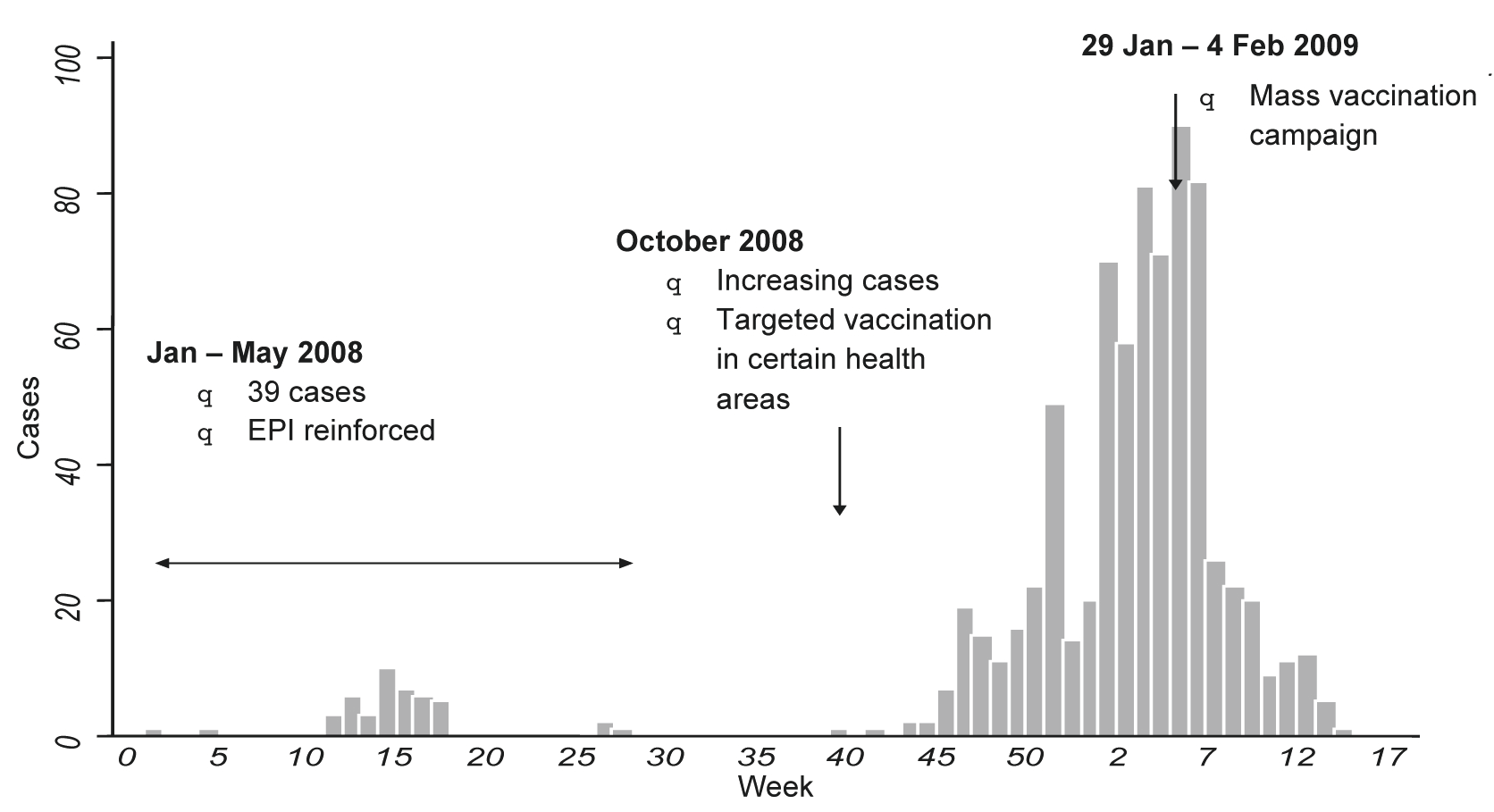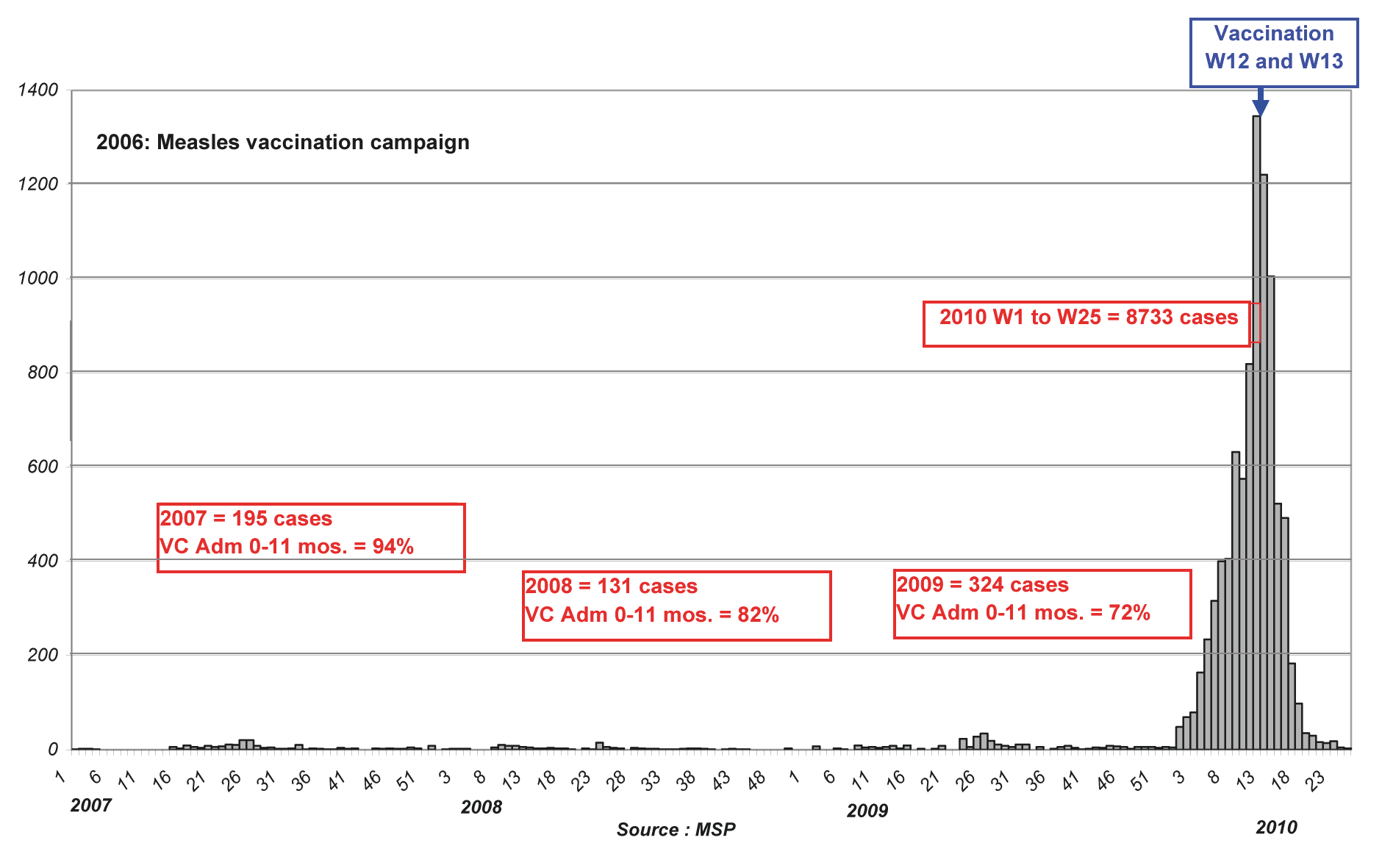Maroua, Cameroon, 2008-2009[1]Citation 1.Luquero FJ, Pham-Orsetti H, Cummings DA, Ngaunji PE, Nimpa M, Fermon F, Ngoe N, Sosler S, Strebel P, Grais RF. A long-lasting measles epidemic in Maroua, Cameroon 2008- 2009: mass vaccination as response to the epidemic. J Infect Dis. 2011 Jul;204 Suppl 1:S243-51. doi: 10.1093/infdis/jir093.
The city of Maroua has an estimated population of 273,170.
The curve shows:
- an increase in the number of cases in May 2008 (39 cumulative cases);
- another increase in October 2008 in certain neighbourhoods, coinciding with an influx of refugees. A vaccination campaign targeting children ages 9 months to 5 years was conducted in these areas;
- despite that intervention, the number of measles cases continued to rise, with a peak in late January 2009.
A total of 875 cases and 8 deaths were reported between 1 January 2008 and 6 April 2009. The epidemic lasted seventeen weeks.
Number of measles cases, Maroua, Cameroon, 2008-2009
Several actions were taken:
- early 2008: routine vaccination (EPI 9-11 months) reinforced in the health centres in the affected areas;
- october 2008: selective vaccination of children ages 9-59 months (unvaccinated) in certain affected areas;
- late January 2009, given the continuing increase in measles cases: non-targeted mass vaccination campaign for children ages 9 months to 15 years, thirteen weeks after the outbreak started.
A vaccination coverage (VC) survey was used to evaluate the coverage achieved by the successive approaches:
- 74.1% (95% CI: 70.0%-78.3%) of children were vaccinated by the routine EPI, with low coverage among children ages 9 to 24 months (66%);
- 28.1% (95% CI: 22.3%-33.9%) during targeted vaccination campaigns in October 2008;
- 79.7% (95% CI: 76.4%-82.9%) during the non-targeted campaign in January 2009.
After these interventions, the estimated VC was over 90% in children ages 9 months to 15 years.
6.1% of children were still unvaccinated after these interventions. The main reasons for a child not receiving routine vaccination were refusal (25%) and lack of information (22%). For the targeted vaccination and the non-targeted campaign, the primary reason was the lack of information (37%).
The EPI’s inadequate vaccination coverage allowed a recrudescence of cases in some neighbourhoods.
Reinforcing vaccination activities did not prevent an outbreak.
The vaccination campaign conducted a few weeks after the start of the outbreak helped control its spread (decline in incidence two weeks after the campaign ended). The outbreak ended in Week 14.
N’Djamena, Chad, 2010
The city of N’Djamena has an estimated population of 1,133,794.
The last measles outbreak occurred in 2005, with 8,015 reported cases (attack rate = 660/100,000). A vaccination campaign targeting children ages 6 months to 5 years was conducted 2006.
The curve shows that:
- From 2007 to 2009, there were few reported cases and the routine vaccination coverage (VC) dropped year by year.
- In 2008, a vaccination campaign (SIA) was conducted in all districts. The overall VC was an estimated 68% (90%, 71%, 68% and 63% in the northern, southern, central and eastern districts, respectively).
- In early 2010 there was an increase in the number of cases: 689 cases from Week 1 to 7, with an attack rate that was four times higher than in previous years. There were significant disparities between districts; the attack rate in the eastern district was 6.3 times higher than in the northern district, 1.8 times higher than in the southern district, and 1.5 times higher than in the central district.
- In Week 7, an investigation was conducted and EPI vaccination reinforced.
- Despite that intervention, the number of cases increased, reaching a peak in Week 12.
A total of 8,733 cases and 32 deaths were reported from Week 1 to Week 25. The outbreak lasted sixteen weeks.
Number of measles cases per week. N’Djamena, Chad. 2007 to 2010
Several actions were taken in response to this outbreak:
- beginning at Week 7: reinforcement of EPI (9-11 months);
- from Week 12 (10 weeks after the start of the outbreak) to Week 15, non-targeted mass vaccination campaign for children ages 6 months to 15 years.
A vaccination coverage survey assessed the VCs before and after the mass vaccination campaign:
- before the campaign, overall VC for children ages 6 months to 15 years: 70.4% (95% CI: 68.5%-72.3%);
- after the campaign, overall VC for children ages 6 months to 15 years: 82.5% (95% CI: 81.5%-83.5%).
The main reasons for non-vaccination were: practical reasons (37%), vaccination refusal (25%), lack of information (14%), previous vaccination (1%), and no explanation (16%).
The VC (EPI + 2008 mass vaccination campaign) was inadequate and allowed a recrudescence of cases in early 2010 (even larger in neighbourhoods where vaccination coverage was lowest).
Reinforcing EPI activities did not prevent an epidemic.
The belated outbreak response vaccination (10 weeks after the epidemic started) helped control its spread (incidence fell in the weeks that followed), and the outbreak ended around Week 22.
- 1.Luquero FJ, Pham-Orsetti H, Cummings DA, Ngaunji PE, Nimpa M, Fermon F, Ngoe N, Sosler S, Strebel P, Grais RF. A long-lasting measles epidemic in Maroua, Cameroon 2008- 2009: mass vaccination as response to the epidemic. J Infect Dis. 2011 Jul;204 Suppl 1:S243-51. doi: 10.1093/infdis/jir093.

